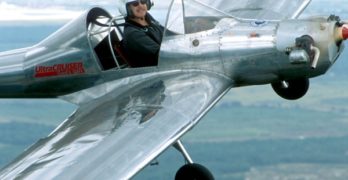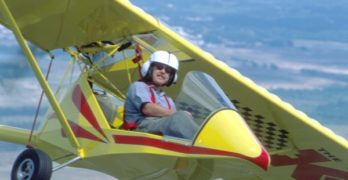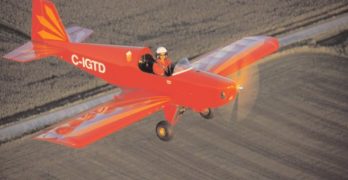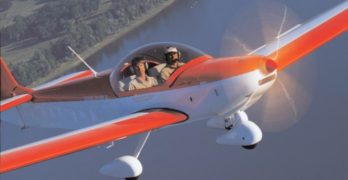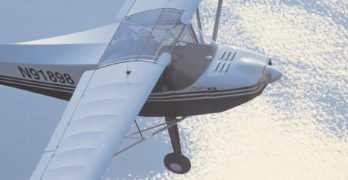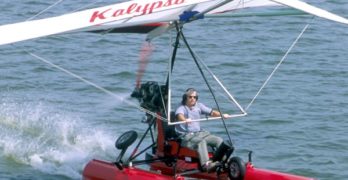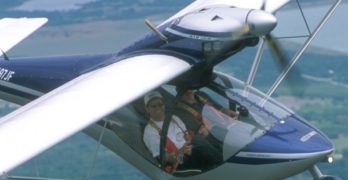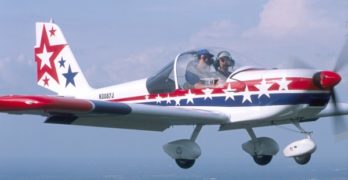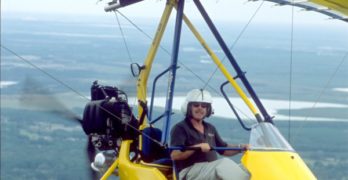A Gift of Design
The UltraCruiser was born under rather unusual circumstances. Its designer, Morry Hummel, was not a young engineer with a passion for flying ultralights. On the contrary, Hummel is one of aviation’s pioneers with many years of experience. His story identifies how he found the time to create the UltraCruiser and, in particular, why the ultralight is fully named UltraCruiser, God’s Gift.
Hummel wrote, “I crashed my miniMAX on July 19, 1995. I lost my right leg below the knee, my left leg was badly broken, and my face crushed. My teeth were wired shut for 10 weeks and I was fed through a tube in my stomach.
“While I was in the hospital for 5 months, I had time to think. God had spared my life for a reason. The UltraCruiser is named God’s Gift because I am only 85 years young and flying again.”
I found it an inspiring story.
Search Results for : Flight Design
Not finding exactly what you expected? Try our advanced search option.
Select a manufacturer to go straight to all our content about that manufacturer.
Select an aircraft model to go straight to all our content about that model.
New Kolb’s FireStar, Flyer and Sport 600
Once Kolb’s FireStar was a new design; a second-generation evolution for the company then headquartered in Pennsylvania. The first Kolb single-seaters were later joined by the TwinStar, the company’s original 2-seater, all of which preceded the FireStar series.
Under the direction of Homer Kolb and Dennis Souder, the original Kolb Company followed their success with the FireStar by creating the Mark III 2-seater, FireFly single-seater, and SlingShot tandem 2-seater. They also worked on but never released the Laser.
In 1999 Bruce Chesnut and Brian Blackwood purchased Kolb Aircraft from Dennis Souder who, along with other partners had owned the enterprise since 1994. Chesnut and Blackwood renamed the company The New Kolb Aircraft Company and moved it to new facilities at the Chesnut Knolls Aviation Foundation Airpark in London, Kentucky.
The Kentucky-based company has focused on model revisions such as the Kolbra and King Kolbra, and the Mark III Xtra. Most recently, The New Kolb Aircraft Company has entered the powered parachute market with their Flyer, and to the proposed Light-Sport Aircraft segment with the Pelican Sport 600.
Murphy Aircraft Returns to Its Roots
After ever-bigger Rebels, the JDM – 8 is a genuine ultralight
Darryl Murphy’s commitment to
small plane design is evident
by the fact that during the
years when Murphy Aircraft Mfg. exhibited
in two locations at various
fly-ins, Darryl frequently was seen
working his company’s booth in the
ultralight area. Other Murphy Aircraft
staff members would be working the
Rebel/Super Rebel booth. At the Northwest
EAA Fly-In in Arlington,
Washington, this past summer, that
pattern re-emerged; the boss stayed
with the JDM-8 in the ultralight exhibit
area. In my conversations with
him, he seemed pleased to be presenting
a genuine ultralight again.
Those who know the history of
Murphy Aircraft before the first Rebel
arrived won’t be surprised to see the
company marketing an ultralight.
This Canadian manufacturer was an
ultralight company that expanded
into homebuilts and has achieved success
through their Rebel series. The
new single-seat JDM-8—especially
when contrasted with the huge, radialengine-
powered Moose—shows this
company has not forgotten its roots in
ultralight aircraft.
Zenith’s Sport Pilot Entry
Chris Heintz’s Zodiac CH 601 XL design fits perfectly
Chris Heintz is a respected designer of light aircraft, and the
Zenith Aircraft Co., led by his sons Sebastian and Nick, is a successful
kit manufacturer with worldwide impact. The company’s
Zodiac line is a well-accepted series of aircraft with good performance
and handling. So, why did I think the Zodiacs were boring?
The answer’s simple—because they
look like little Piper Cherokees.
Now, both New Piper Aircraft and
Zenith make fine aircraft with
better-than-expected performance for
their class. But they’re just…well…conventional,
expected, familiar. They seem
to be a factory sedan at a sports car show.
A flight in the Zodiac XL with Nick
changed my view. I now have a better
understanding of the solid reputation of
this Canadian designer, this company,
and these aircraft. I greatly enjoyed the
hour Nick and I spent buzzing about the
central Florida landscape.
The Zodiac Line
Developed by Chris Heintz, the Zodiac
line today includes four different models.
Rans S-6S Coyote II
As the dawn of the sport pilot rule changes approaches,
Kansas-based RANS Inc. is one of the
most successful kit aircraft manufacturers in the
light aviation industry.
Randy Schlitter, RANS’ boss and founder, is now a seasoned
veteran of the kit airplane business. Over his
years in business, he has created several popular aircraft
designs that have found favor in the United
States, Europe, and about 50 other countries around
the globe.
Of the broad RANS line, the one model that has most revved up
buyers is the S-6S Coyote II. Despite competition from hundreds of
other aircraft, the Coyote line has sold an impressive fleet of 1,500 aircraft. The single-place version, S-4/5, first
flew 20 years ago and has also sold reasonably
well, but it is the Coyote II that
has become the single most successful
RANS design.
The two-place Coyote II is available in
two models—the S6-S and the S-6ES.
Efficient Amphib Trike; The Kalypso
My computer dictionary says Calypso is “A sea nymph who delayed Odysseus on her island for 7 years.” It is also the name of one of Saturn’s moons, a flower, and a West Indian musical style. Any of these meanings infer a pleasant experience, a sensation sure to be duplicated by the ultralight amphibious Kalypso (spelled with a “K”) with its Krücker-designed floats.
I don’t know if the Kalypso is enough to keep you stuck on an island for 7 years, but I found her to be a most desirable ultralight.
Take It Home with You
Trikes are highly mobile aircraft. One reason they became so popular in Europe and even here in the roomier US of A is that they break down easily. You can carry a trike in a pickup truck – with the right hardware added to properly support chassis and wing. Or you can use a small trailer and carry the wing on your car or truck.
Get Up to Speed; Jet Fox 97
Sleek with curvaceous lines, the Jet Fox 97 commands attention, even when surrounded by other desirable flying machines. Welcome to Italian company Euro ALA and its candidate for the proposed Light-Sport Aircraft category. Sergio Cremonesi, the factory representative with whom I would fly the racing-looking Jet Fox 97, told me the “ALA” stood for Advanced Light Aircraft.
Advanced, indeed! I’d seen this machine in France at airshows in ’98 and ’99. I snapped photos of it and wherever I showed those pictures, ultralight pilots smiled with appreciation. In the finest Italian sense (think Ferrari), the Jet Fox 97 has the lines and looks to draw closer inspection.
One look inside – all Jet Fox 97s I’ve seen appear to be similarly outfitted – and those smiles morph into grins. The panel looks like something out of a fighter aircraft. A color flat glass display is flanked by the usual assortment of “steam gauges,” installed with engineering precision.
Sportstar Sidebar
Why Buy this Plane over Another?
I asked the question of U.S. dealer James Peeler. He’s been a Flightstar dealer and pilot for several years and is “one of us” ultralight pilots. Now that he represents the Czech aircraft, he should be able to relate why the model excites him.
The EV-97 EuroStar aka SportStar has been manufactured for more than 6 years in the Czech Republic and has been used as a trainer in Europe without even one service bulletin or airworthiness directive issued, Peeler says. The factory has achieved the ISO 9001 quality standard certification.
More pragmatically, Peeler says, “The plane flies better overall as a trainer than anything I have ever flown in my 22 years of flying with more than 5,500 hours in 103 different aircraft (general aviation, Experimental, rotorcraft, and ultralight).
“The performance is uncanny,” he continues. “It gets off like an ultralight (in less than 300 feet) and climbs like a homesick angel at between 1,200 to 1,500 fpm with two aboard, cruises at 100 to 120 mph, Vne 167 mph, and stall at 38 mph.” I didn’t find the ground roll as short nor the climb as strong, but perhaps Peeler’s technique is that much better than mine.
SportStar for American Pilots
They’re already lining up out front though the party isn’t sure to happen. I’m writing about the FAA’s Light-Sport Aircraft proposal and those aircraft that intend to cash in on the new opportunity if the proposal becomes the law of the land.
Should ultralight pilots embrace this proposal? Or is it merely another niche of aviation that won’t substantially change how many ultralight pilots operate their aircraft?
Many true-to-the-breed ultralight designs are already kit-built, N-numbered aircraft flown by pilots with an FAA certificate. Lots of others prefer the light-handed Part 103 rule.
Light-Sport Aircraft, while potentially more capable, are going to carry much higher price tags and more government involvement. However, the kit business isn’t going to disappear nor are genuine Part 103 ultralights. (The last statement is the beginning of another story but I can easily demonstrate how Part 103 aircraft will remain an important part of the market.)
Still, the Light-Sport Aircraft proposal has considerable energy and may become law during 2003.
Aquilair’s Comfortable 2-Seater
French manufacturer Aquilair wants you to get in the “swing” of triking with their 2-seat trike, the Swing. The trike’s sporty name identifies what the French company calls their “chariot” (chassis or carriage). The name may also derive from the company’s unique fold-down system.
Most trikes pivot at the base of the mast (the component connecting occupants and engine to wing) or at a mid-mast point about engine height. Aquilair pivots the mast under the front seat – or the only seat in the case of their single-place model, the Kid. Placing the pivot point this far forward allows the company to offer easier lifting of the wing into position without using weighty and costly gas struts. The result is a simpler, lighter package that accomplishes the goal of letting one person erect the trike from its transport state.
The feature is driven, I was told, by the 90-pound female owner of Aquilair.
- « Previous Page
- 1
- …
- 138
- 139
- 140
- 141
- 142
- …
- 148
- Next Page »


